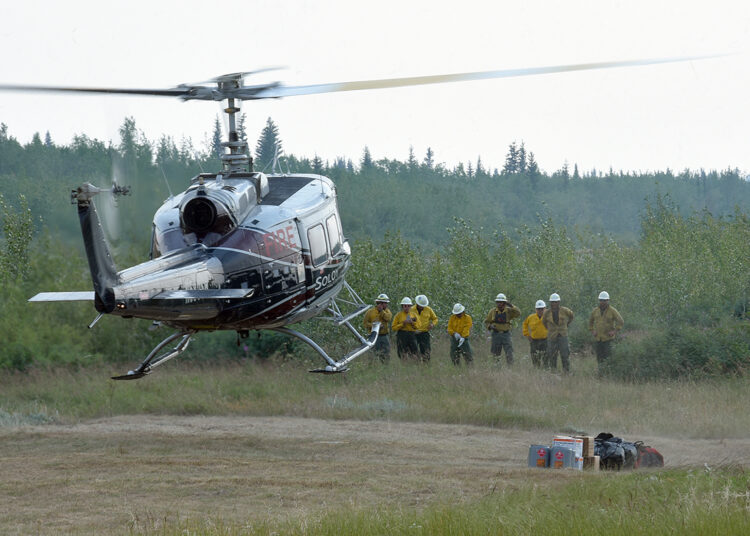WASHINGTON DC – Inadvertent Instrument Meteorological Conditions leading to pilot spatial disorientation continue to be a leading cause of fatal helicopter accidents. From 2000 to 2019 in the United States, there were 130 fatal accidents directly linked to the issue of spatial disorientation. These accidents occurred regardless of pilot experience and they cut across all industries, including Emergency Medical Services, law enforcement, tour operations, utility flights, corporate flying and personal/private flights.
“For decades, studies, articles, research papers, and discussions have been published theorizing why accidents related to degraded visual environments consistently occur and it has been hard to find clear answers that can slow or stop these tragic accidents,” explains Nick Mayhew, industry co-chair of the U.S. Helicopter Safety Team. “In part, the accidents stem from failed planning, lack of understanding, or poor decision-making. All pilots have the option to turn down a flight before launch, turn around, proceed to an alternate, or land in a safe place if the weather deteriorates below company or personal minimums, yet we continue to see these types of accidents.”
In response to this situation, the U.S. Helicopter Safety Team has developed a new Recommended Practices document focusing on “Spatial Disorientation Induced by a Degraded Visual Environment” and offering training and decision-making solutions.
“We are proposing a shift in the way we discuss, train and react to deteriorating or unplanned weather conditions,” adds Mayhew.
The Recommended Practices document (https://ushst.org/56secs/) focuses on these training and decision-making actions:
- Avoidance of IIMC
- Preflight planning that includes enroute decision processes
- In-aircraft training that simulates a lack of visibility
- Training of recovery techniques and committing to instruments
Avoidance of IIMC - Avoidance is the best defense. There are several tools at a pilot’s disposal to ensure they put themselves, the crew, and the safety of their passengers in the best position for a successful flight. Often, that may be opting to delay or cancel the launch based on conditions present or anticipated during the flight. These decisions can be difficult to make, but when a pilot conducts a thorough preflight analysis, the preponderance of evidence can make that risk management decision straightforward and data-based.
Preflight Planning that Includes Enroute Decision Processes – Enroute Decision Triggers can be defined as a pre-determined set of conditions that “trigger” a decision point in the flight. When a preset decision trigger is reached, the pilot executes a predetermined action that was planned, briefed, and reviewed while at the planning table. The enroute decision triggers should be planned early in the preflight planning process to prevent other factors to impact them. These decisions should be planned and discussed for every flight – not just the flights where you anticipate weather to be an issue.
In-Aircraft Training that Simulates a Lack of Visibility – To be best prepared for a degraded visual environment, the USHST recommends a framework on which to build a comprehensive training program. This includes a no-visibility simulation while in-aircraft, simulators that offer visual illusion training and simulations that expose pilots to visual illusions and affect their vestibular system.
Training of Recovery Techniques and Committing to Instruments - The best techniques for survival of spatial disorientation encounters is to avoid them. However, with proper training, pilots can be more successful in trusting instruments. For pilots to trust their instruments, they have to train the brain to disregard the vestibular illusions experienced during spatial disorientation. This is accomplished by simultaneously exposing a pilot to visual and vestibular illusions in training. This exposure will provide the brain the training it requires to function in “fast brain” and successfully disregard the conflicting illusions and focus on the instruments. The USHST document also discusses techniques such as stabilized power, U.S. Army AHTTA training and the PAB method.
This USHST Recommended Practice document (found at https://ushst.org/56secs/) is intended to provide an initial framework for future comprehensive training packages aimed at reducing helicopter accidents stemming from spatial disorientation.
It is one of several significant safety initiatives developed by the USHST (www.USHST.org) to reduce the number of fatal accidents. Other safety enhancements include:
- White paper showing how UAS (drones) can supplement and support manned helicopters in high-risk operations and environments. https://ushst.org/low-altitude-ops/
- New airmanship bulletins on the Vortex Ring State and on Power Available Limitations. http://ihsf.aero/index.php/resources/airmanship-bulletins/
- Recommended practices document and a fact sheet offering guidelines for preflight inspections and final walk-arounds. http://ihsf.aero/Recommended/Rec%20Prac%2028%20Walk%20Around%20FINAL.pdf
- In collaboration with the FAA and the GAJSC, promotion of a new reference tool for pilots about how impairment can be caused by certain over-the-counter medications. https://www.faa.gov/licenses_certificates/medical_certification/media/OTCMedicationsforPilots.pdf?fbclid=IwAR3qjlPBrBrsCRbS2XoWmrtoeSbaUHfKQXf23W_Oq2B-L6QczA15RhHCtCE
- An extensive Recommended Practices Guide regarding the use of simulation to rehearse at-risk scenarios and develop safe decision-making. https://ushst.org/USHST_RP_Simulation_Training_for_DM2.pdf
- Recommended Practices Guide and briefing card on the use of Crew Resource Management for civil helicopter crews. https://ushst.org/customers-crews/
- “Go Local” interactive safety workshops modified from a face-to-face setting to an interactive webinar version. Developed in conjunction with the FAASTeam and focused on reinforcing a culture of safety among pilots within the helicopter community. https://ushst.org/go-local/
More information about the USHST, the International Helicopter Safety Foundation, its reports, safety tools, Reel Safety audio-visual presentations, and YouTube safety videos can be obtained at www.USHST.org, at www.IHSF.aero and on the USHST and IHSF Facebook pages.






